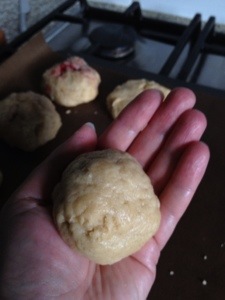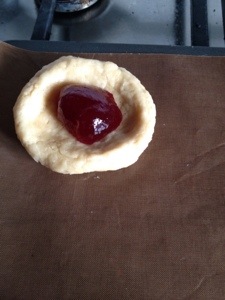The internet, should you ask it, will give you carloads of raspberry bun recipes. There’s one here or here or even here. But to my mind, where modern cake-bakers and recipe-writers fall down is in their hidebound insistence on ingredients you might actually be able to find, instructions you can understand, and an end product you might want to eat. Where’s the fun in that? So go ahead, would-be raspberry bun chef, fly to the arms of those recipes. Go now, I won’t mind. I understand that not all of you are cut out to attempt ‘making a bay’ or are ready to have the veil lifted on the mysterious VOL, or perhaps you will never want to know why this week’s baking recalled ‘cleaning out the sheds at the turkey farm’ to the mind of my husband.
Here’s Mary’s recipe:
(before we go on, I didn’t cut that little slip out of the top of the page myself. I think Mary must have, because you’ll see that she’s put the title of the recipe at the bottom there)
Today we’re doing the digressions before the recipe. Scroll down if you don’t care and you just want the recipe. If I were you, though, I’d seriously consider taking a look at one of the recipes I’ve linked above. One of my ingredients is quite difficult to find, and I honestly cannot decide just what I think about my finished product. Our problem here is different from previous weeks – it is quite clear from looking at other raspberry bun recipes what we’re supposed to end up with, but there’s a bit of crossword-like puzzle solving before we can get there.
What is vol? Where can I lay my hands on it?
I got here in the end via a hunch, a bit of word association, and a lucky find in a Chinese supermarket. I seemed to recall – though Google Image Search is having none of it – that I’d seen chemists’ jars marked ‘Sal Vol.’ in the past, short for sal volatile. If you put ‘sal volatile’ into Wikipedia, you end up here, on the page for Ammonium Carbonate. It is a short step from there to the article on Ammonium Bicarbonate. Both substances seem to be used as smelling salts (like in this passage from Alice Through the Looking-Glass, where ‘sal-volatile’ is suggested for someone who has just fainted) but also as a raising agent. In fact it still is used as a raising agent elsewhere. Over at London Eats, it’s used to make delicious-sounding Swedish drömmar biscuits, in America it’s known as ‘baker’s ammonia’, and in this German packaging it’s suggested that it’s irreplaceable for making Pfeffernüsse or Lebkuchen. Meanwhile, over here in the UK, it’s perhaps not surprising that I’ve never come across it before as this clip from the Glasgow Herald in 1959 describes readers reacting with shock to an instruction to put smelling salts into their chocolate cake mix, but – clincher! – says that it’s known as ‘vol’ in the baking trade.
Shortly after finding all this out, I was slouching along the dry goods aisle of Charlton’s best Chinese supermarket when I saw a package labelled Ammonium Carbonate.
The Wikipedia page on Ammonium Bicarbonate linked above tells us that ‘in China it is called edible or food-grade “smelly powder”‘ They are not wrong in China. This stuff reeks. To me it recalled chemistry lessons, and being told about how you had to hold a test tube and waft the smell of unknown chemicals towards your nose WITHOUT INHALING. My husband however was taken back to his teenage weekend job, cleaning out the sheds at a poultry farm. It is not a good smell, not at all.
How do I ‘make a bay’?
We’d call it ‘making a well’. ‘Making a bay’ was still in use in the UK in 1951, when these recipes from the London Transport Canteen Catering Recipe Book were published, and still seems to be in use in India, as in this recipe for Tandoori Roti
Ingredients
-
340g plain flour
85g butter
1 tsp cream of tartar
half tsp bicarbonate of soda
half tsp ammonium carbonate
85g sugar
1 egg
70ml buttermilk (possibly a bit more)
Raspberry jam for filling – around 4 tbsp. (If you have less than half a jar left I’d get another jar or make something else)
1 additional egg for the wash
Makes 10 buns, 11 at a pinch
You’ll also need:
Food processor (not absolutely necessary but will make your life a bit easier)
baking sheet
Method
Heat the oven to 180C, and prepare a baking sheet with greaseproof paper or a silicone sheet if you have one.
Either rub the butter into the flour with your fingertips or cheat and process in the food processor until it looks like this:
Tip into a bowl, mix in the raising agents (cream of tartar, bicarb and vol) and make a well in the centre of the flour mixture.
Beat the egg and sugar together, then pour into the well in the flour mixture:
Mix together, then add the buttermilk, to get to ‘a nice paste’ as Mary says. I used a little (say a dessertspoon or so) over the 70ml
You should end up with a mixture slightly looser than Playdoh that you can knead a bit in the bowl:
If you are a habitual cake-mix taster, try to restrain yourself this once. The vol will break up into byproducts in the oven and you’ll find if you taste it before then you’ll regret it. The good news is that you haven’t poisoned yourself though.
Again Mary suggests that the correct measure per bun is 2.5 oz, around 70g. For reference that’s about this big:
(I have your average sized hand, I think)
Now roll into a rough ball, press down to make a crater in the centre, and put about half a teaspoon of jam in the centre. If you, too, have eyes bigger than your stomach you will feel tempted to put more jam in – try to resist.
Bring the sides of the dough over the jam and press together on top. I got better at this as I went along:
But not quite so good at it that there weren’t massive fissures in the buns after baking as you’ll see at the top of the page. I’d suggest moistening the dough with some water when you press together. I didn’t do this…
Brush over a beaten egg:
And place in the oven until the buns are risen and golden-brown. It took my buns between 20 and 25 minutes to bake. You might be able still to smell ammonia when you take them out of the oven. I could at first, but it went away quickly, and I wasn’t able to taste anything wrong with them.
What do they taste like?
I think to be fair I should try these again in winter – they’re definitely a bit heavy in July. They are an odd scone-like mix of light and stodgy, and I found myself rationing the jammy bits so that I could swallow the bun bits. A bit like the lemon buns, they are claggy; the sort of confection where the back of your mouth is gummed up after a bite or two. Scone fans (I’m not really one) may wolf these down.









